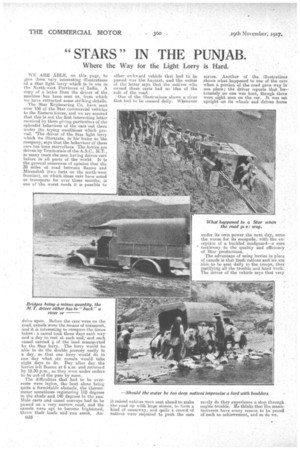6 6 STARS" IN THE PUNJAB.
Page 14

If you've noticed an error in this article please click here to report it so we can fix it.
Where the Way for the Light Lorry is Hard.
WE ARE ABLE, on this page, to give three very interesting illustrations of a Star light lorry which is in use in the North-west Provinces of India. A copy of a letter from the driver of the machine has been sent us, from which we have extracted some striking details.
The Star Engineering Co. have sent over 150 of the Star commercial vehicles to the Eastern forces, and we are assured that this is not the first interesting letter received by them giving particulars of the splendid behaviour of the cars out there under the trying conditions which prevail. 'The driver of the Star light lorry which we illustrate, in hisletter to the company, says that the behaviour of these cars has been marvellous. The lorries are driven by Territorials of the A.S.C., MT., in many cases the men haying driven cars
i before nall parts of the world. It is the general consensus of opinion that the 39 miles of road between Bannu and Miranshah (two forts on the north-west frontier), on which these cars have acted as transports for over three months, is one of the worst roads it is possible to
drive upon. Before the cars'were on the road, camels ,were the means of transport, and it is interesting to compare the times taken : a camel took three days each way and a day to rest at each end; and each camel carried of the load transported by the Star lorry. The lorry would be able to do the double journey easily in a day, so that one lorry would do in one day what six camels would take eight days to do. Day 'after day the lorries left Bannu at 6 a.m. and returned by 12.30 p.m., as they were under orders to he out of the pass by noon. The difficulties that had to be overcome were legion, the heat alone being quite a formidable obstacle, the thermometer sometimes registering 118 degrees in the shade and 140 degrees in the sun. Mule carts and camel convoys had tobe passed on a very narrow. road, and the camels were apt to become frightened, throw their loads and Tun amok. An
C38 other awkward vehicle that had to be passed was the haycart, and the writer of the letter says that the natives who owned these earth had no idea of the rule of the read.
One of the illustrations shows a river that had to be creased daily_ Whenever it rained natives were sent ahead to make the road up with huge stones, to form a kind of causeway, and qesite a crowd, of natives were required to push the cars across. Another of the, illustrations shows what happened to one of the cars when a portion of the road gave way in one place ; the driver reports that fortunately no one was hurt, though there were eight men on the car. It was set upright on its wheels and driven home rarely do they experience a stop through engine trouble. He thinks that the manufacturers have every reason to be proud of such. an achievement, and so do we.'
























